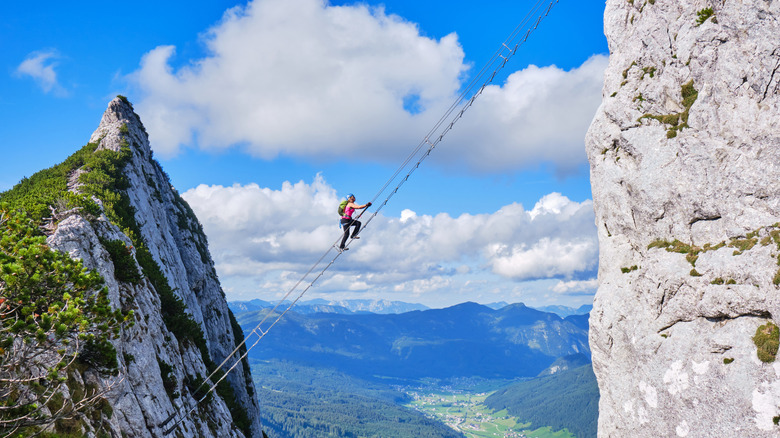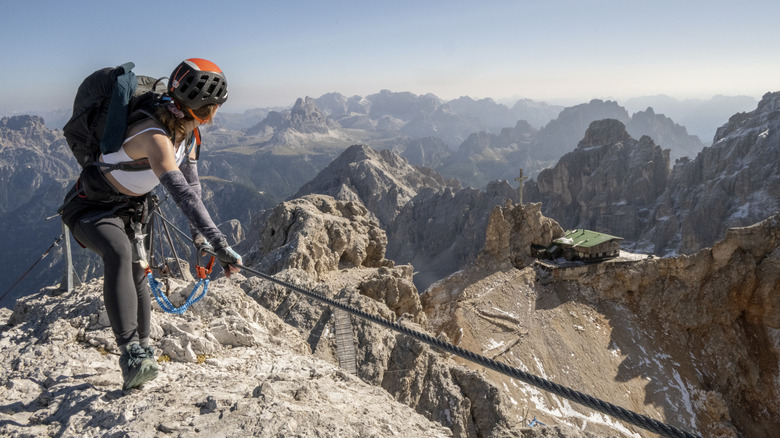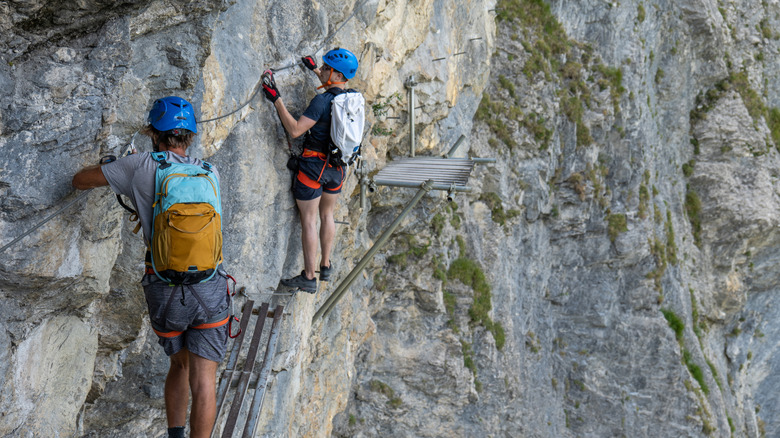You'll Need Nerves Of Steel To Try This Trendy Mountain Climbing Craze Borrowed From WWI
Once upon a time, rock climbing was an esoteric sport, with knowledge passed climber-to-climber in remote and rugged locales. Avid practitioners of the art called themselves "dirtbags" and were the OG vanlifers, long before anyone had ever heard of a hashtag. Then climbing gyms exploded across the country, and movies like the Oscar-winning documentary "Free Solo" made rock stars out of climbers like Alex Honnold. Suddenly, everyone wants to feel what it's like to cling to the side of a sun-warmed cliff as endorphins and adrenaline create a thrilling cocktail of fear and exhilaration — and presto, today rock climbing is huge in the U.S.
But the latest trend to catch fire in the North American climbing world, among amateurs and experts alike, is something entirely new — which turns out to be quite old where it first originated, in the Italian Alps. Climbers of all abilities are flocking to "via ferratas," established climbing routes supplemented with steel cables, railings, metal rungs, and gangways to facilitate clambering over otherwise impassable routes while safely clipped into a harness.
Italian for "iron path," this technique is named after a practice that came into being during World War I, when the Italian military used permanently affixed steel climbing aids to help troops cross otherwise impossible passes high in the Dolomite Alps. Before this, a handful of fixed routes had been created in the Alps and Pyrenees, used mainly by early mountaineering enthusiasts, but it wasn't until the Great War and after that numerous via ferratas began to be constructed in the Dolomites. Today the region is a summertime mountain playground for safety-conscious daredevils.
How a via ferrata works
To scale a via ferrata, you'll wear a helmet, a harness, and a double-ended shock-absorbing cable that will take up the slack should you fall — you'll always clip one end in before unclipping the other, so that you're attached to a safety device at all times. You won't need to wear fancy climbing shoes, just sturdy footwear fit for scrambling.
While a via ferrata may be slightly easier than rock climbing, it's not exactly a walk in the park. The risk of plunging to your death may not be ever-present, but the fear factor definitely is. You might find yourself traversing a chasm by walking along a narrow cable while holding onto a second cable for balance, or scaling a "staircase" of ladder rungs suspended hundreds of feet in the air. At other times, you'll climb ladder-like rungs of metal set into rock.
Also remember that accessible to beginners isn't the same thing as easy. You'll need strength, stamina, coordination, and a tolerance for altitude to successfully climb a via ferrata. Most U.S. via ferratas, including more moderate ones like the routes at Arizona's Castle Hot Springs, can only be done with a guide. There, the hardest route, to the summit of Castle Peak, is recommended for those with previous via ferrata or rock climbing experience.
Where you'll find via ferratas
There are now more than twenty via ferrata courses in the United States, including at least eight in Colorado. Beginners through advanced climbers can climb the city-owned, nonprofit Ouray Via Ferrata in the charming ski town of Ouray, Colorado, with or without a guide, for free, although safety equipment is required. Many of the new routes in the U.S., like this one, as well as others in Telluride, Colorado, and Tahoe, California, are being built at ski resorts, to provide summertime thrills when the downhill skiing stops. There are at least seven routes at this luxurious Red Rock Country Utah resort. The highest via ferrata in the U.S. is Colorado's Arapahoe Basin, or "A-Basin" for short, which you can tackle in a full-day guided experience that deposits you, sweaty and satisfied, on a 13,000-foot summit for triumphant views.
The trend is growing in new ways, too. Columbus, Ohio, built one in an old quarry that is being called the first urban via ferrata. But if you get into the sport stateside, you'll want to put Europe on your bucket list, because there are over 1,000 routes there, with a greater variety of skill levels required. Visit the Swiss Alps in the fall shoulder season and you can beat the crowds to tackle the Via Ferrata Mürren-Gimmelwald in Bern, Switzerland. With ladders, cliffs, and a suspension bridge, along with breathtaking views as a reward for your effort, it's a popular course for beginners, and can be done guided or not, with companies renting the requisite gear near the trailhead. Then you can work your way across Europe, to the hardest one of all, Spain's terrifying Extraplomix, in the Canary Islands. Viva ferrata!


